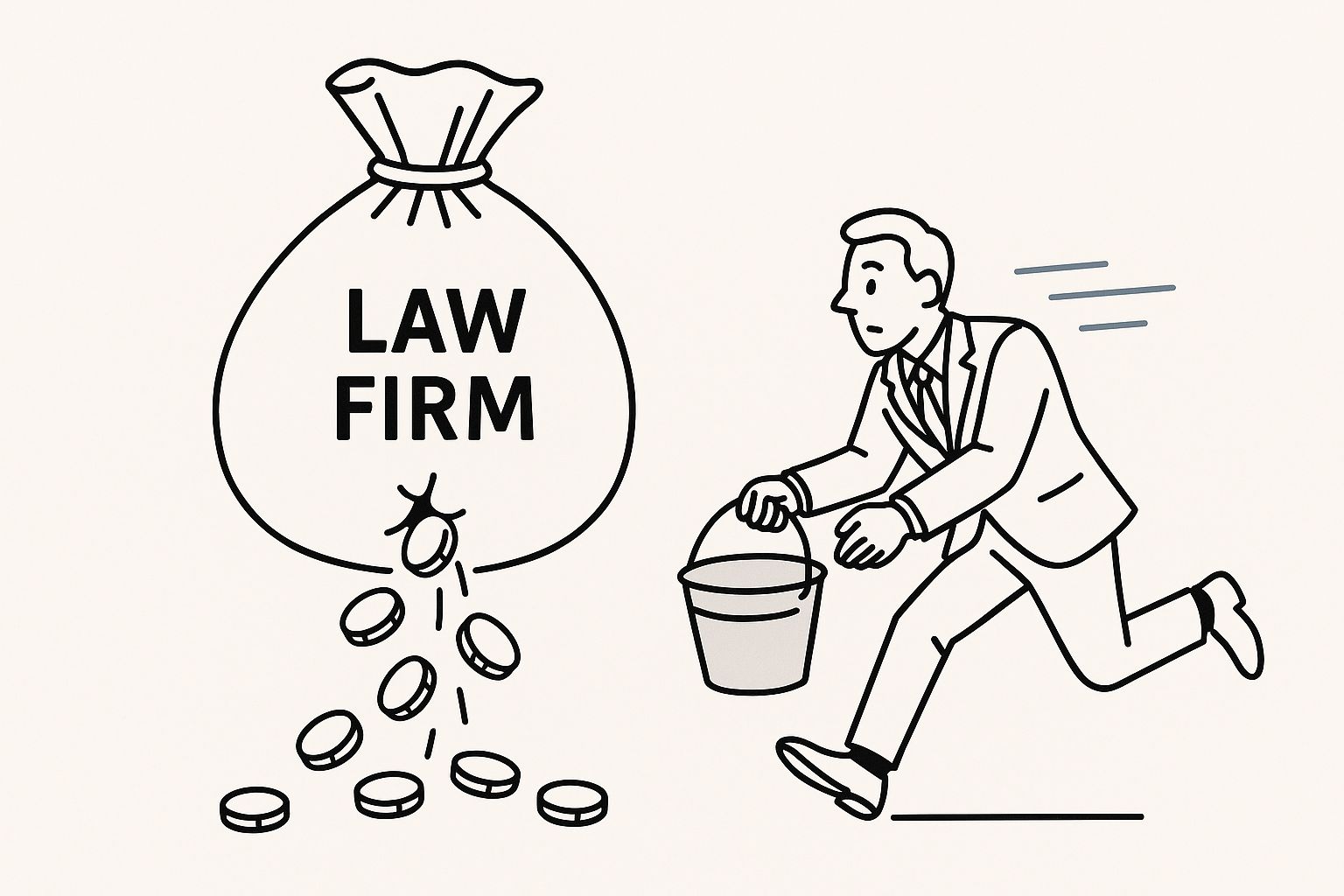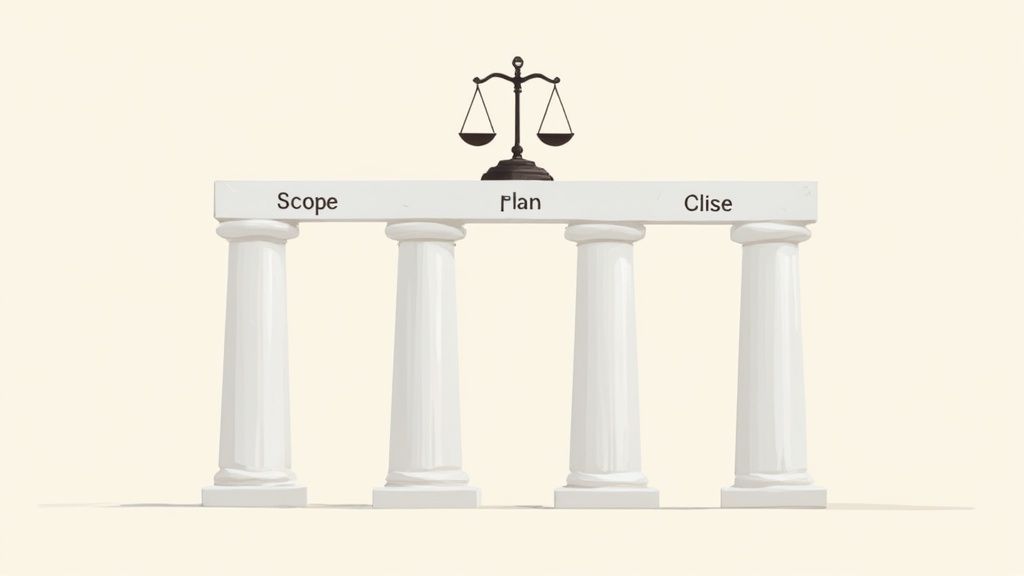
 15 minutes read
15 minutes read
Let's be blunt: legal project management (LPM) is your law firm's battle plan. It’s the system that stops the constant firefighting and lets you start winning cases profitably. Forget the MBA jargon for a moment. At its core, LPM is about applying proven project management principles—scope, budget, schedule—to the beautifully chaotic world of law.

Think of it this way: you wouldn't build a house without a blueprint, a budget, and a timeline. So why are you running a multi-million dollar litigation case on sticky notes and a prayer? Legal project management is the blueprint for your legal work.
It’s a structured way to manage legal matters from intake to closing. Instead of reacting to every client email and court deadline like it's a shocking plot twist, you plan for them. You define what "done" looks like before you even start, estimate costs without just guessing, and keep everyone—especially the client—in the loop.
This isn't about adding another layer of soul-crushing bureaucracy or forcing your star litigators to fill out timesheets in triplicate. It’s about creating a predictable, profitable, and less stressful way to practice law. The whole point is to eliminate those awful surprises, like the end-of-month client call about an unexpectedly massive bill.
LPM transforms legal work from a series of reactive, unfortunate events into a controlled process. It’s a fundamental mindset shift that brings business discipline to the practice of law. You move from "we'll see how it goes" to "here is the plan."

The core idea is simple: Treat every legal matter like the complex project it is. Define the scope, manage the budget, communicate proactively, and deliver a predictable outcome. That’s it. That’s the magic.
And firms are catching on. LPM has clawed its way out of the back office and into a strategic necessity. A Bloomberg Law survey found that more than one-third of firms now bill for their legal project management professionals, proving it’s a valued, revenue-generating function. It’s no longer a "nice-to-have"; it's a competitive advantage.
Here's a quick look at the mindset shift. It's less about working harder and more about working smarter.
| Area of Focus | The Old Way (Hope as a Strategy) | The LPM Way (Strategy as a Strategy) |
|---|---|---|
| Scope | Scope creep is just part of the job. We'll figure it out as we go. | The scope is defined upfront. Changes are formally discussed and approved. |
| Budget | We'll bill our hours and the client will pay. The final cost is a surprise. | We create a budget based on the scope. We track costs and keep the client informed. |
| Communication | We update the client when something major happens or when they ask. | Regular, scheduled communication is part of the plan. No surprises. |
| Process | Each lawyer has their own way of doing things. It's an art, not a science. | We use standardized processes and templates to ensure consistency and efficiency. |
| Client Role | The client is an observer who receives the final bill. | The client is a partner in the process, aligned on goals and expectations. |
This table really throws the difference into sharp relief. It's about building a system that supports great legal work, rather than just hoping for a good outcome.
Ever finish a major case, feel that rush of victory, and then see a profit margin so thin it’s barely there? That’s the slow, silent bleed of a firm running on instinct instead of a solid process. You're losing money in places you don't even realize.
It often starts with the small stuff. The "quick phone call" that morphs into a year-long engagement. The budget that was more of a hopeful guess than a data-backed estimate. These aren't just minor missteps; they're symptoms of a systemic issue that's quietly draining your firm's profitability.
This infographic paints a pretty accurate picture of a firm trying to manage complex work without a system—constantly putting out fires and scrambling to plug financial leaks.

This isn't just a cartoon. For many firms, it's a Tuesday. A reality where being "busy" gets confused with being profitable.
The $500 Hello. Scope creep is the silent killer of your bottom line. It’s that constant drip of "while you're at it" or "just one more thing" from a client that quietly adds hundreds of unbilled hours to a matter. Without a clearly defined scope—a foundational element of legal project management—you have no guardrails. You’re left hoping the client is feeling generous when the final, much larger bill arrives.
Here’s the all-too-familiar way it plays out:

A firm without LPM is essentially handing clients a blank check and hoping they don’t run up the tab. It's a terrible way to do business, and it's completely avoidable.
Trying to manage this internal chaos is both exhausting and expensive. Many smart firms are finding that offloading routine, process-driven tasks through legal outsourcing services is a game-changer. It helps control costs and lets your highly-paid lawyers focus on high-value legal work, not administrative firefighting.

So, what does putting legal project management into practice actually look like? This isn’t some abstract theory from a textbook you’ll never open again. It’s a real, repeatable framework built on four core pillars.
Think of this as a practical system you can apply to your very next case, whether you're handling a straightforward contract review or navigating a beast of litigation.
This is your first line of defense against the dreaded scope creep we all know and loathe. Before you draft a single motion, you have to clearly define what success looks like. That means spelling out what’s included in the work, and just as critically, what’s not.
Here, you create a project charter that a client can actually understand—not a 50-page tome of legalese. This charter becomes your North Star for the entire matter. It's the document you can point to when a client asks for "just one more thing."
Once you know where you’re going, you need to draw the map. This pillar is all about breaking down the big picture into manageable phases and individual tasks. Who does what? By when? And for how much?
This is where you build a communication plan that finally kills those endless "just checking in" emails that torpedo your morning. It’s also the perfect time to implement some smart workforce planning strategies to make sure you have the right people on the job without overstaffing.

You’re not just planning the legal strategy; you’re planning the business of the case. It’s a subtle but powerful shift in thinking that separates the profitable firms from the busy ones.
The rest of the business world has been doing this for decades. A staggering 80% of project managers consider portfolio management essential for success, a mindset that translates perfectly to managing a law firm’s caseload. You can dig into more stats in this deep dive from PM360 Consulting.
Alright, time to work the plan. This is the "doing" phase, but it's fundamentally different from the old way of working. You aren't just reacting to whatever lands in your inbox; you're executing with purpose, guided by the scope and plan you’ve already established.
This phase is all about active management:
When the case is wrapped, don’t just send the final bill and sprint to the next fire. The closing phase is where the real learning happens. You conduct a post-mortem to figure out what went well and what could have been better.
This isn't about pointing fingers. It's about gathering intel to refine your process, ensuring the next project runs even more smoothly.
Alright, let's talk tech. The market is absolutely flooded with software promising to solve all your problems, each with a price tag that might make you wince. Many of these tools are bloated, over-engineered platforms built for tech companies, not for lawyers staring down a discovery deadline.
You do not need to mortgage your office ping-pong table to get started. Honestly, the best tool is the one your team will actually use.
You can kick off a surprisingly effective LPM system with basic task managers you might already know, like Asana or Trello. They're simple, often free to start, and a massive improvement over managing a complex case with email chains and a prayer.
The free tools are great… until they’re not. You’ll know it’s time to level up when you find yourself constantly asking:
When you spend more time managing the tool than managing the actual case, it’s a clear sign you’ve outgrown it. This is where dedicated legal platforms come in, but even here, you need to be ruthless about what really matters. Ignore the flashy Gantt charts you will never, ever touch.

The goal isn’t to find the software with the most features; it’s to find the one with the right features that your team can adopt without a three-week training course and a dedicated IT professional.
Instead of getting distracted by shiny objects, focus on platforms that nail the fundamentals of legal work. A lot of firms find a sweet spot by combining a straightforward task management system with robust legal case management software. This approach keeps daily to-dos crystal clear while ensuring all case-related documents, deadlines, and communications are securely centralized.
The demand for these efficiency tools is skyrocketing. The wider project management software market is projected to be worth $10 billion by 2026, a clear signal that every industry, including legal, is hunting for smarter ways to work.
To help you choose the right type of software for your practice, here's a simple guide to get you started.
| Firm Type / Size | Good Starting Point | When You Need to Upgrade |
|---|---|---|
| Solo / Small Firm (1-5 attorneys) | Free versions of Trello, Asana, or even a well-organized spreadsheet. | When you're managing more than 10 active cases and document version control becomes a nightmare. |
| Mid-Sized Firm (5-20 attorneys) | Dedicated legal case management software with built-in task management. | When you need advanced reporting, client portals, or integrations with accounting software. |
| Large Firm (20+ attorneys) | Enterprise-level legal practice management suites with customizable workflows and robust security features. | When you need firm-wide business intelligence, advanced analytics, and compliance tracking. |
The right tool will feel less like an expense and more like hiring your most efficient employee. For a deeper dive, you can explore some of the best legal case management software options available today to see how the landscape is shaping up.
Theory is one thing, but making it work in the real world is where the magic happens. Let’s talk about how to actually get legal project management off the ground in your firm—without sparking a full-blown mutiny. And no, the first step isn't to take out a second mortgage on the office to buy some fancy new software.
It’s much simpler than that. Find one partner who’s willing to be a guinea pig. Just one. Then, pick a single, medium-sized matter to test it on. That’s your whole mission. Your goal is to create one undeniable success story that gets everyone else in the firm talking.
Forget about a massive, top-down mandate. That’s a surefire way to have your emails ignored and face a quiet rebellion from the people you’re trying to help. What you're aiming for is a grassroots movement, one that starts small and grows because it works.
For this pilot project, you need a crystal-clear definition of what a “win” looks like. Don't get bogged down in a dozen different metrics. Just focus on a few tangible outcomes:
This isn’t about layering on more bureaucracy. It’s about demonstrating that a bit of structure actually frees people up and makes the firm more profitable. You're not selling them a management textbook; you're offering them a practical solution to their biggest headaches.
To get that initial buy-in, you have to deliver value right out of the gate. Forget those long, drawn-out kickoff meetings that everyone dreads. Instead, run a quick, focused 15-minute huddle with a clear purpose. Your best tool for this is a simple project charter—a single page that spells out the goals, what’s in and out of scope, and who’s responsible for what.

Implementing LPM isn’t a revolution; it’s an evolution. Prove the value on a small scale, document the win, and let the results speak for themselves. Soon enough, other partners will be asking how they can get in on the action.
Alright, you've stuck with us this far, which means you're probably intrigued but maybe a little skeptical. Good. Let's tackle some of the most common questions and hesitations we hear from law firms dipping their toes into Legal Project Management.
Not at all. Thinking LPM is only for massive cases is like believing only professional chefs should use recipes. While it's an absolute game-changer for complex, multi-year litigation, the core principles are universal.
Think about it: defining a clear scope, setting a realistic budget, and communicating effectively are valuable for any legal matter. Applying a simplified version of LPM to a standard contract review or a routine real estate closing helps build powerful habits. It makes efficiency the default mode for your whole firm, not an exception for the big cases.
Let's be honest—some might resist at first. Change is uncomfortable. The key is how you frame it. This isn't about piling on more administrative busywork; it's about giving them a better way to work.

LPM is a shield against their biggest frustrations. It cuts down on those angry client calls about surprise bills, eliminates the frantic late-night scrambles caused by scope creep, and frees them up to focus on what they do best: practice law. Once they see it makes their lives easier, you'll win them over.
For most small to mid-sized firms, that’s probably overkill. You don't need to bring in a PMP-certified expert to get started.
Often, the best person to lead the charge is already on your team. It could be a motivated paralegal, a detail-oriented legal assistant, or even an associate who has a natural talent for organization. The goal is to adopt the LPM mindset and use simple, effective tools, not to collect certifications. Toot, toot.
Feeling the strain of managing projects while trying to find top-tier talent? HireParalegals can take the hiring pressure off. We connect you with pre-vetted, remote legal professionals in as little as 24 hours, letting you focus on implementing LPM instead of reviewing resumes. Find your next superstar here.